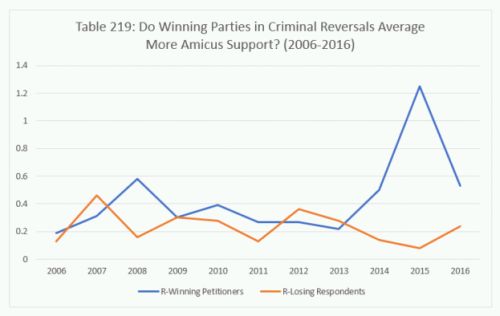Yesterday, we analyzed the Court's experience with amicus briefs in criminal cases between 1994 and 2005. Today, we'll look at the Court's experience with amicus briefs in criminal cases between 2006 and 2016.
Winners averaged more amicus support than losing parties in criminal affirmances only about one-third of the time during this period. In 2006, neither winners nor losers received any amicus support in affirmances. In 2007, winners averaged 0.21 amicus briefs, and losing parties averaged 0.15. In 2008, winners averaged 0.1 briefs to 0.23 for losers. In 2009, winners averaged 0.11 briefs to 0.31 for losers. In 2010, winning parties averaged 0.02 amicus briefs to 0.25 for losers.
In 2011, winning parties (the respondents) averaged 0.03 amicus briefs to 0 for losing parties. In 2012, winning parties averaged 0.1 briefs to 0.24 for losing parties. In 2013, winning parties averaged 0.04 amicus briefs to 0 for losers. In 2014, winning parties averaged 0.74 amicus briefs to 0.16 for losing parties. In 2015, neither side received any amicus support, and in 2016, winning parties received 0.13 extra briefs to 0.09 for losing parties.

In Table 219, we focus on reversals in criminal cases. For these years, winning petitioners averaged more amicus support than losers somewhat more than half the time. For 2006, winners averaged 0.19 amicus briefs to 0.13 for losers. For 2007, winning parties averaged 0.31 briefs to 0.46 for losing parties. In 2008, petitioners – the winning party – averaged 0.58 amicus briefs in support to 0.16 for losing parties. In 2009, both sides averaged amicus support from 0.3 parties. In 2010, winners averaged 0.39 briefs to 0.28 for losing parties. In 2011, petitioners received amicus support from 0.27 amici to 0.13 for respondents. In 2012, winning petitioners received amicus support from 0.27 parties to 0.36 for respondents. In 2013, winners received an average of 0.22 briefs in support to 0.28 for losing parties. In 2014, petitioners averaged half an amicus brief per party to 0.14 for losing parties. In 2015, winners averaged 1.25 amicus briefs to 0.08 for losing parties. In 2016, winning parties averaged 0.53 briefs to 0.24 for losing parties.

Lastly, we turn our attention to partial reversals. In 2006, petitioners averaged 0.18 briefs in partial reversals to 0 for respondents. Neither side received amicus support in 2007, 2008 or 2009. In 2010, petitioners averaged 1.33 amicus briefs more to 0.17 more for respondents. Neither side received any amicus support in 2011 or 2012. In 2013, petitioners averaged 0.2 amicus briefs to 0.4 for respondents. Neither side received any additional support in 2014. In 2015, petitioners averaged one amicus brief to 0.18 for respondents. Finally, in 2016, petitioners averaged 0.27 amicus briefs in both partial affirmances and partial reversals.

Join us back here tomorrow as we continue our data analytic review of the Court's decision making.
The content of this article is intended to provide a general guide to the subject matter. Specialist advice should be sought about your specific circumstances.

